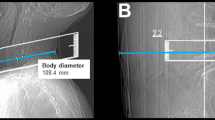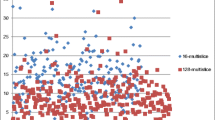Abstract
Purpose
To develop and evaluate a technical approach for CT-guided periradicular infiltration using quantitative needle access and guidance parameters extracted from CT scout images.
Methods
Five 3D-printed phantoms of the abdomen mimicking different patients were used to develop a technical approach for scout-guided periradicular infiltration. The needle access point, puncture depth, and needle angulation were calculated using measurements extracted from anterior-posterior and lateral CT scout images. Fifty needle placements were performed with the technique thus developed. Dose exposure and number of image acquisitions were compared with ten procedures performed using a conventional free-hand technique. Data were analyzed with the Mann-Whitney U test.
Results
Parameters derived solely from scout images provided adequate guidance for successful and reliable needle placement. Needle guidance was performed with the same equipment as the standard periradicular infiltration. Two scout images and 3.5 ± 2.3 (mean ± SD) single-shot images for needle positioning were acquired. Mean DLP ± SD was 3.8 ± 2.5 mGy cm. The number of single-shot acquisitions was reduced by 68% and the overall dose was reduced by 84% in comparison with the conventional free-hand technique (p < 0.0001).
Conclusion
Scout-guided needle placement for periradicular infiltration is feasible and reduces radiation exposure significantly.




Similar content being viewed by others
References
Lee K-S, Lin C-L, Hwang S-L, Howng S-L, Wang C-K (2005) Transforaminal periradicular infiltration guided by CT for unilateral sciatica—an outcome study. Clin Imaging 29(3):211–214. https://doi.org/10.1016/j.clinimag.2004.07.025
Wagner AL (2004) CT fluoroscopy–guided epidural injections: technique and results. Am J Neuroradiol 25(10):1821–1823
Deml MC, Buhr M, Wimmer MD, Pflugmacher R, Riedel R, Rommelspacher Y, Kabir K (2015) CT-guided infiltration saves surgical intervention and fastens return to work compared to anatomical landmark-guided infiltration in patients with lumbosciatica. Eur J Orthop Surg Traumatol 25(1):177–182. https://doi.org/10.1007/s00590-015-1602-9
Maurer MH, Schreiter N, de Bucourt M, Grieser C, Renz DM, Hartwig T, Hamm B, Streitparth F (2013) Cost comparison of nerve root infiltration of the lumbar spine under MRI and CT guidance. Eur Radiol 23(6):1487–1494. https://doi.org/10.1007/s00330-012-2757-y
Manchikanti L, Singh V, Falco FJE, Benyamin RM, Hirsch JA (2014) Epidemiology of low back pain in adults. Neuromodulation: Technology at the Neural Interface 17:3–10. https://doi.org/10.1111/ner.12018
Brenner DJ, Hall EJ (2007) Computed tomography — an increasing source of radiation exposure. N Engl J Med 357(22):2277–2284. https://doi.org/10.1056/NEJMra072149
Seals KF, Lee EW, Cagnon CH, Al-Hakim RA, Kee ST (2016) Radiation-induced cataractogenesis: a critical literature review for the interventional radiologist. Cardiovasc Intervent Radiol 39(2):151–160. https://doi.org/10.1007/s00270-015-1207-z
Elsholtz FH, Schaafs LA, Kohlitz T, Hamm B, Niehues SM (2017) Periradicular infiltration of the lumbar spine: testing the robustness of an interventional ultra-low-dose protocol at different body mass index levels. Acta Radiol:284185117694508. https://doi.org/10.1177/0284185117694508
Elsholtz FHJ, Schaafs LA, Erxleben C, Hamm B, Niehues SM (2017) Ultra-low-dose periradicular infiltration of the lumbar spine: spot scanning and its potential for further dose reduction by replacing helical planning CT. Radiol Med 122:705–712. https://doi.org/10.1007/s11547-017-0766-2
Paik NC (2016) Radiation dose reduction in CT fluoroscopy-guided cervical transforaminal epidural steroid injection by modifying scout and planning steps. Cardiovasc Intervent Radiol 39(4):591–599. https://doi.org/10.1007/s00270-015-1230-0
Amrhein TJ, Schauberger JS, Kranz PG, Hoang JK (2016) Reducing patient radiation exposure from CT fluoroscopy-guided lumbar spine pain injections by targeting the planning CT. AJR Am J Roentgenol 206(2):390–394. https://doi.org/10.2214/AJR.15.14436
Chintapalli KN, Montgomery RS, Hatab M, Katabathina VS, Guiy K (2012) Radiation dose management: part 1, minimizing radiation dose in CT-guided procedures. Am J Roentgenol 198(4):W347–W351. https://doi.org/10.2214/AJR.11.7958
Moser C, Becker J, Deli M, Busch M, Boehme M, Groenemeyer DHW (2013) A novel laser navigation system reduces radiation exposure and improves accuracy and workflow of CT-guided spinal interventions: a prospective, randomized, controlled, clinical trial in comparison to conventional freehand puncture. Eur J Radiol 82(4):627–632. https://doi.org/10.1016/j.ejrad.2012.10.028
Jacobi V, Thalhammer A, Kirchner J (1999) Value of a laser guidance system for CT interventions: a phantom study. Eur Radiol 9(1):137–140. https://doi.org/10.1007/s003300050644
Gruber-Rouh T, Lee C, Bolck J, Naguib NNN, Schulz B, Eichler K, Aschenbach R, Wichmann JL, Vogl TJ, Zangos S (2015) Intervention planning using a laser navigation system for CT-guided interventions: a phantom and patient study. Korean J Radiol 16(4):729–735. https://doi.org/10.3348/kjr.2015.16.4.729
Mokry A, Willmitzer F, Hostettler R, Richter H, Kircher P, Kneissl S, Wetzel S (2019) Evaluation of a novel, patient-mounted system for CT-guided needle navigation—an ex vivo study. Neuroradiology 61(1):55–61. https://doi.org/10.1007/s00234-018-2107-0
Jahnke P, Schwarz FB, Ziegert M, Almasi T, Abdelhadi O, Nunninger M, Hamm B, Scheel M (2018) A radiopaque 3D printed, anthropomorphic phantom for simulation of CT-guided procedures. Eur Radiol 28(11):4818–4823. https://doi.org/10.1007/s00330-018-5481-4
Gaspoz F, Monnin P, Petter D, Plé J, Ding S (2015) Precision and accuracy of measurements on CT scout view. J Med Imaging Radiat Sci 46(3):309–316. https://doi.org/10.1016/j.jmir.2015.06.006
Artner J, Lattig F, Reichel H, Cakir B (2012) Effective radiation dose reduction in computed tomography-guided spinal injections: a prospective, comparative study with technical considerations. Orthop Rev 4(2):e24. https://doi.org/10.4081/or.2012.e24
Funding
This study has received funding from the Bundesministerium für Wirtschaft und Energie (DE): 03EFHBE093.
Author information
Authors and Affiliations
Corresponding author
Ethics declarations
Conflict of interest
PJ and MS are shareholders of a company manufacturing CT phantoms.
Ethical approval
All procedures performed in studies involving human participants were in accordance with the ethical standards of the institutional and/or national research committee and with the 1964 Helsinki declaration and its later amendments or comparable ethical standards.
Informed consent
Informed consent was obtained from all individual participants included in the study.
Additional information
Publisher’s note
Springer Nature remains neutral with regard to jurisdictional claims in published maps and institutional affiliations.
Rights and permissions
About this article
Cite this article
Nunninger, M., Braun, V.P.B., Ziegert, M. et al. Scout-guided needle placement—a technical approach for dose reduction in CT-guided periradicular infiltration. Neuroradiology 62, 341–346 (2020). https://doi.org/10.1007/s00234-019-02339-1
Received:
Accepted:
Published:
Issue Date:
DOI: https://doi.org/10.1007/s00234-019-02339-1




